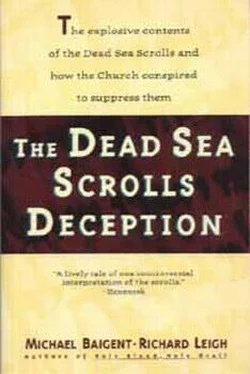All of this ended, of course, with the accession of Herod in 37 bc, installed as a puppet by the Romans who had overrun Palestine a quarter of a century before. At first, before he had consolidated his position, Herod was also preoccupied by questions of legitimacy. Thus, for example, he contrived to legitimise himself by marrying a Maccabean princess. No sooner was his position secure, however, than he proceeded to murder his wife and her brother, rendering the Maccabean line effectively extinct. He also removed or destroyed the upper echelons of the priesthood, which he filled with his own favourites and minions. These are the ‘Sadducees’ known to history through biblical sources and through Josephus. Eisenman suggests that the term ‘Sadducee’ was originally a variant, or perhaps a corruption, of’Zadok’ or ‘ Zaddikirn — the ‘Righteous Ones’ in Hebrew, which the priesthood of the Maccabeans unquestionably were. 8The ‘Sadducees’ installed by Herod were, however, very different. They were firmly aligned with the usurping monarch. They enjoyed an easy and comfortable life of prestige and privilege. They exercised a lucrative monopoly over the Temple and everything associated with the Temple. And they had no concept whatever of ‘zeal for the Law’. Israel thus found itself under the yoke of a corrupt illegitimate monarchy and a corrupt illegitimate priesthood, both of which were ultimately instruments of pagan Rome.
As in the days of Mattathias Maccabaeus, this situation inevitably provoked a reaction. If Herod’s puppet priests became the ‘Sadducees’ of popular tradition, their adversaries — the ‘purists’ who remained ‘zealous for the Law’ — became known to history under a variety of different names. 9In certain contexts — the Qumran literature, for example — these adversaries were called ‘Zadokites’ or ‘Sons of Zadok’. In the New Testament, they were called ‘Nazorenes’ — and, subsequently, ‘early Christians’. In Josephus, they were called ‘Zealots’ and ‘Sicarii’. The Romans, of course, regarded them as ‘terrorists’, ‘outlaws’ and ‘brigands’. In modern terminology, they might be called ‘messianic revolutionary fundamentalists’. 10
Whatever the terminology one uses, the religious and political situation in Judaea had, by the beginning of the 1st century AD, provoked widespread opposition to the Herodian regime, the pro-Herodian priesthood and the machinery of the Roman Empire, which sustained and loomed behind both. By the 1st century ad, there were thus two rival and antagonistic factions of ‘Sadducees’. On the one hand, there were the Sadducees of the New Testament and Josephus, the ‘Herodian Sadducees’; on the other hand, there was a ‘true’ or ‘purist’ Sadducee movement, which repudiated all such collaboration and remained fervently loyal to three traditional governing principles — a priesthood or priestly ‘Messiah’ claiming descent from Aaron, a royal ‘Messiah’ claiming descent from David and, above all, ‘zeal for the Law’. 11
It will by this time have become clear to the reader that ‘zeal for the Law’ is not a casually used phrase. On the contrary, it is used very precisely in the way that such phrases as ‘brethren of the craft’ might be used in Freemasonry; and whenever the phrase, or some variant of it, occurs, it offers a vital clue to the researcher, indicating to him a certain group of people or movement. Given this fact, it becomes strained and disingenuous to argue — as adherents of the consensus do — that there must be some distinction between the Qumran community, who extol ‘zeal for the Law’, and the Zealots of popular tradition.
The Zealots of popular tradition are generally acknowledged to have been founded at the dawn of the Christian era by a figure known as Judas of Galilee, or, more accurately perhaps, Judas of Gamala. Judas launched his revolt immediately after the death of Herod the Great in 4 bc. One particularly revealing aspect of this revolt is cited by Josephus. At once, ‘as soon as mourning for Herod was over’, public demand was whipped up for the incumbent Herodian high priest to be deposed and another, ‘of greater piety and purity’, to be installed in his place. 12Accompanied by a priest known as ‘Sadduc’ — apparently a Greek transliteration of ‘Zadok’, or, as suggested by Eisenman, Zaddik, the Hebrew for ‘Righteous One’ — Judas and his followers promptly raided the royal armoury in the Galilean city of Sepphoris, plundering weapons and equipment for themselves. Around the same time — either just before or just after — Herod’s palace at Jericho, near Qumran, was attacked by arsonists and burned down. 13These events were to be followed by some seventy-five years of incessant guerrilla warfare and terrorist activity, culminating in the full-scale military operations of AD 66-73.
In The Jewish Wars, written in the volatile aftermath of the revolt, Josephus states that Judas of Galilee had founded ‘a peculiar sect of his own’. 14Josephus’ second major work, however, Antiquities of the Jews, was composed a quarter of a century or so later, when the general atmosphere was rather less fraught. In this work, therefore, Josephus could afford to be more explicit. 15He states that Judas and Sadduc ‘became zealous’, implying something tantamount to a conversion — a conversion to some recognised attitude or state of mind. Their movement, he says, constituted ‘the fourth sect of Jewish philosophy’, and the youth of Israel ‘were zealous for it’. 16From the very beginning, the movement was characterised by Messianic aspirations. Sadduc embodied the figure of the priestly Messiah descended from Aaron. And Judas, according to Josephus, had an ‘ambitious desire of the royal dignity’ — the status of the royal Messiah descended from David. 17
Judas himself appears to have been killed fairly early in the fighting. His mantle of leadership passed to his sons, of whom there were three. Two of them, Jacob and Simon, were well-known ‘Zealot’ leaders, captured and crucified by the Romans some time between AD 46 and 48. The third son (or perhaps grandson), Menahem, was one of the chief instigators of the revolt of AD 66. In its early days, when the revolt still promised to be successful, Menahem is described as making a triumphal entry into Jerusalem, ‘in the state of a king’ — another manifestation of messianic dynastic ambitions. 18In AD 66, Menahem also captured the fortress of Masada. The bastion’s last commander, known to history as Eleazar, was another descendant of Judas of Galilee, though the precise nature of the relationship has never been established.
The mass suicide of ‘Zealot’ defenders at Masada has become a familiar historical event, the focus of at least two novels, a cinema film and a television mini-series. It has already been referred to in this book, and there will be occasion to look at it more closely shortly. Masada, however, was not the only instance of such mass suicide. In AD 67, responding to the rebellion sweeping the Holy Land, a Roman army advanced on Gamala In Galilee, the original home of Judas and his sons. Four thousand Jews died trying to defend the town. When their efforts proved futile, another five thousand committed suicide. This reflects something more than mere political opposition. It attests to a dimension of religious fanaticism. Such a dimension is expressed by Josephus, who, speaking of the ‘Zealots’, says: ‘They… do not value dying any kinds of death, nor indeed do they heed the deaths of their relations and friends, nor can any such fear make them call any man Lord…’ 19To acknowledge a Roman emperor as a god, which Rome demanded, would have been, for the ‘Zealots’, the most outrageous blasphemy. 20To such a transgression of the Law, death would indeed have been preferable.
Читать дальше












